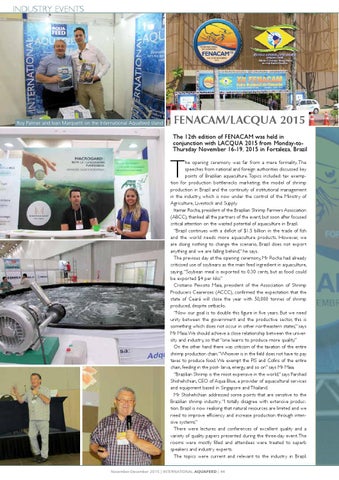INDUSTRY EVENTS
An event of excellence Roy Palmer and Ivan Marquetti on the International Aquafeed stand
FENACAM/LACQUA 2015
by Ivan Marquetti, Latin American International Aquafeed Regional Director
The 12th edition of FENACAM was held in conjunction with LACQUA 2015 from Monday-toThursday November 16-19, 2015 in Fortaleza, Brazil
T
he opening ceremony was far from a mere formality. The speeches from national and foreign authorities discussed key points of Brazilian aquaculture. Topics included: tax exemption for production bottlenecks marketing; the model of shrimp production in Brazil and the continuity of institutional management in the industry, which is now under the control of the Ministry of Agriculture, Livestock and Supply. Itamar Rocha, president of the Brazilian Shrimp Farmers Association (ABCC), thanked all the partners of the event, but soon after focused critical attention on the wasted potential of aquaculture in Brazil. “Brazil continues with a deficit of $1.5 billion in the trade of fish and the world needs more aquaculture products. However, we are doing nothing to change the scenario, Brazil does not export anything and we are falling behind,” he says. The previous day at the opening ceremony, Mr Rocha had already criticised use of soybeans as the main feed ingredient in aquaculture, saying, “Soybean meal is exported to 0.30 cents, but as food could be exported $4 per kilo.” Cristiano Peixoto Maia, president of the Association of Shrimp Producers Cearenses (ACCC), confirmed the expectation that the state of Ceará will close the year with 50,000 tonnes of shrimp produced, despite setbacks. “Now our goal is to double this figure in five years. But we need unity between the government and the productive sector, this is something which does not occur in other northeastern states,” says Mr Maia. We should achieve a close relationship between the university and industry, so that “one learns to produce more quality.” On the other hand there was criticism of the taxation of the entire shrimp production chain. “Whoever is in the field does not have to pay taxes to produce food. We exempt the PIS and Cofins of the entire chain, feeding in the post- larva, energy, and so on” says Mr Maia. “Brazilian Shrimp is the most expensive in the world,” says Farshad Shishehchian, CEO of Aqua Blue, a provider of aquacultural services and equipment based in Singapore and Thailand. Mr Shishehchian addressed some points that are sensitive to the Brazilian shrimp industry. “I totally disagree with extensive production. Brazil is now realising that natural resources are limited and we need to improve efficiency and increase production through intensive systems.” There were lectures and conferences of excellent quality and a variety of quality papers presented during the three-day event. The rooms were mostly filled and attendees were treated to superb speakers and industry experts. The topics were current and relevant to the industry in Brazil.
November-December 2015 | INTERNATIONAL AQUAFEED | 44
